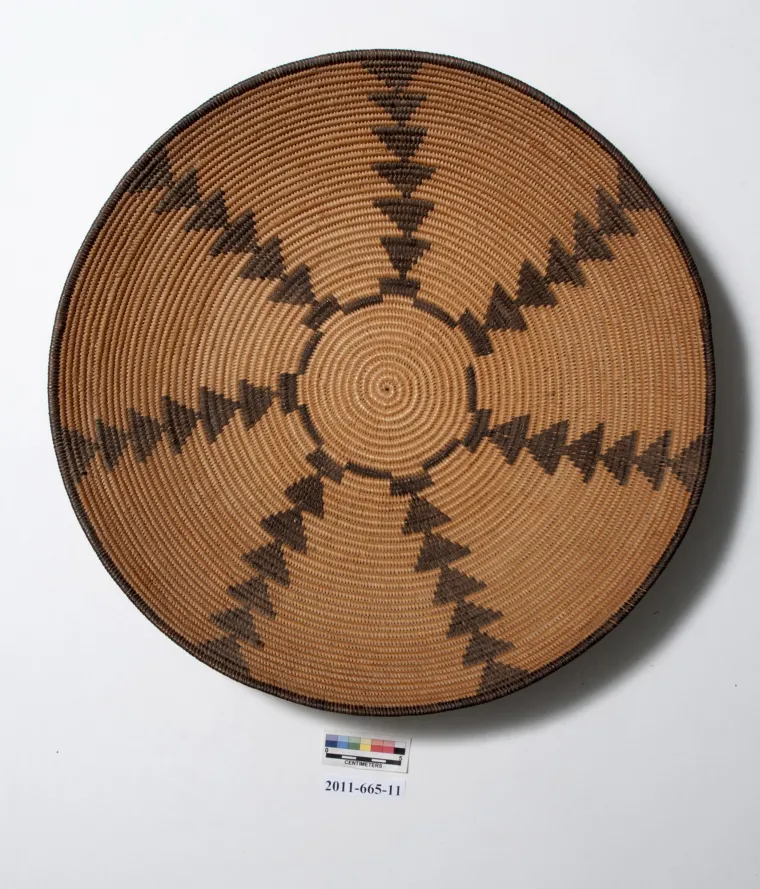
Polychrome Coiled Basketry Bowl
ca. 1860–1900
Gabrieleño / Fernandeño (Tongva)
Los Angeles Basin, California
Coiled basketry
Sumac, juncus
Diameter 17.8 in. (45.2 cm.), Maximum height 3.9 in. (10 cm.)
Collection of John and Clara Lee Tanner, donated by Karl and Sandy Tanner Elers, 2011
(ASM Catalog No. 2011-665-11)
This is a 19th century southern California coiled basket that was recently donated to the museum by the family of the late John and Clara Lee Tanner. I selected this basket as my curator’s choice for four reasons. First, I was in complete awe the first time I saw this basket. Although it was filthy and in terrible condition, the visible design elements indicated that it might be a Chumash basket produced during the 1800s (it turned out, instead, to be Gabrieleño / Fernandeño). Second, it is a utilitarian basket that was actually used. It is very rare and exciting to have a 19th-century southern California coiled basket used for food serving or preparation. Third, all Curator's Choice objects are assessed (and if necessary, treated) by ASM conservators before going on exhibit, and the basket's poor condition made it an excellent candidate for conservation.
Finally, this object gives us the opportunity to show the public how the museum’s preservation division is capable of restoring the beauty and the research potential of a basket like this. Our hope is that the public will help Arizona State Museum build and preserve its basketry collection. We are currently raising money to complete a project, partially funded by a Save America’s Treasures grant, that resulted in the construction of a climate-controlled, visible-storage vault designed to preserve ASM's perishable collections for visitors, researchers, and Native American artists.
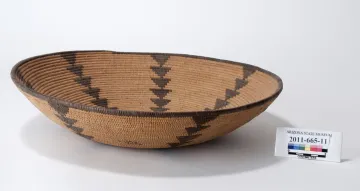
Identifying a California Basket
Native Californian baskets are well known all over the world for their beauty. For many native groups, basketry has proven to be an enduring link with tribal traditions and history. Baskets were and still are used for gathering, processing, cooking, serving, and storing food.
The ability and expertise to identify plant materials used to weave a basket is incredibly important, as raw material choices can often indicate the culture of the weaver. The museum was fortunate to have Dr. Bruce Bernstein, an expert on California basketry, as a judge for our 2012 Southwest Indian Art fair. Dr. Bernstein was able to study the basket while he was here, but before it was treated by ASM conservators, and he sent us some very helpful information.
Dr. Bernstein suggested attribution to the Tejon, Kitanemuck, or Vanyume. Unfortunately, as he notes, “examples of these baskets are scant,” and I was unable to find any examples useful for comparison. I found myself coming back to the fact that the basket had strong Chumash elements. I started to research Fort Tejon and the reservation established there, just north of Los Angeles, where bands of the Chumash, Yokuts, Kawaiisu, and Kitanemuck were relocated to better enable American expansionist policy in the West. With so many different groups together one can imagine a mixture of cultural design influences in basketry. After learning this, it made sense to me how Dr. Bernstein came up with his opinion. The designs along the basket's rim area, called herringbone, are very common among the Chumash. The diamond or "rattlesnake" pattern, is common among the Yokuts and Kawaiisu. Each of these groups was confined to the same area and it would only make sense that basketry artists shared ideas and designs. However, as I mentioned earlier, correctly identifying the plant materials is often the key indicator of the culture of the weaver.
I felt another expert opinion might help to pinpoint a cultural attribution. I contacted Dr. Jan Timbrook, curator of ethnography at the Santa Barbara Museum of Natural History. Dr. Timbrook was happy to help us try to identify the basket. She suggested the basket should be identified as Gabrieleño/Fernandeño.
We then sent the basket to Dr. Nancy Odegaard, conservator and head of our preservation division. After Dr. Odegaard partially cleaned and stabilized the basket, we were able to actually see the materials and confirmed that all the red elements were produced using juncus stem and not yucca root. This was a major component in identifying the culture as likely Gabrieleño / Fernandeño. Dr. Bernstein likely would have made the same material identifications, but had the disadvantage of viewing the basket before it had been treated by conservators.
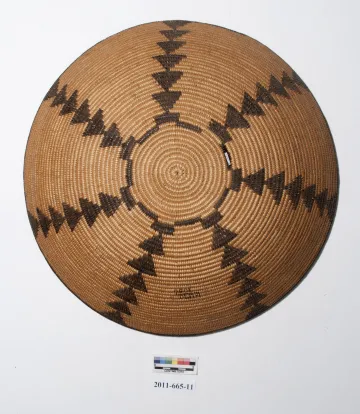
The Gabrieleño / Fernandeño
The name Gabrieleño / Fernandeño derives from the Spanish missions of San Gabriel and San Fernando at which they were confined in colonial times. Their ancestors settled in the Los Angeles, California, area between the Chumash and Digueño tribes, perhaps as early as 500 BCE. They were primarily hunter-gatherers with a heavy dependence on acorns, marine resources, and trade with their neighbors.
The Spanish began building missions in California in 1769 to spread Christianity and to colonize the coast. California Indian tribes were forcibly relocated to live and work in the missions. By 1771 the San Gabriel Mission was established, and in 1797 the San Fernando Mission was founded. The missions ushered in dramatic changes for the Gabrieleño/Fernandeño. They and were forbidden to speak their native language, many converted to Christianity, and many died from European-introduced diseases. The mission system was discontinued 1833 and most former mission lands became ranches. By 1900, smallpox and other diseases had reduced the Gabrieleño/Fernandeño population to a few dozen. Today, there are approximately 1,500 self-identifying members.
California Basketry Today
California Indian basketry is an ancient art, yet one kept alive today by contemporary weavers throughout the state. Weavers, young and old, female and male, from many cultures are now actively revitalizing native basketry traditions. Many basket weavers have joined the California Indian Basketweavers Association (CIBA). This association works to encourage native basketry traditions and to address issues of basketry raw materials availability and access and herbicide use. Each year CIBA holds a gathering that includes demonstrations, exhibits, and other events open to the public.
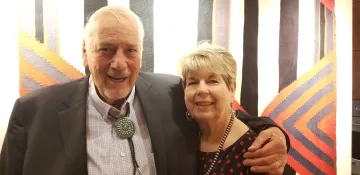
Karl and Sandy Tanner Elers
Generous Donors
This basket is part of a collection of 99 Native American objects owned by the late John and Clara Lee Tanner, and donated to ASM by Sandy Tanner and Karl Elers, their daughter and son-in-law. It was not made for the tourist trade but did end up being displayed and appreciated by the Tanners. Based on the shape it was in and the nail hole in the center, it is safe to say it hung on a wall for many years. Much has been written about the Tanners and a brief section about who they were and what they did for Native American art is in order.
Clara Lee was inducted into the Arizona Women's Hall Of Fame in 2004. Their website contains an obituary by the Arizona Historical Society, from which the following is adapted:
Clara Lee Tanner (1905-1997)
Clara Lee was born in Biscoe, North Carolina, in 1905. She received a Bachelor’s Degree in Archaeology at the University of Arizona and was one of the first three students there to receive a Masters Degree in Archaeology (1928). She pursued graduate studies at the National University of Mexico and at the Oriental Institute of the University of Chicago and was awarded an Honorary Doctor of Letters by the University of Arizona in 1983.
Clara Lee Tanner taught in the Department of Anthropology for half a century. She specialized in Southwest Indian arts and crafts and authored an extensive list of articles and books ranging from newspaper articles to college textbooks in addition to being a regular contributor to Arizona Highways Magazine. For many years she was the recognized authority on Southwest Indian culture and arts. As a highly sought after public speaker she was able to communicate appreciation of the artistic achievements of these people in both the United States and abroad and inspire other’s interest.
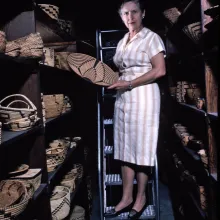
Clara Lee Tanner
Among her numerous awards were the Sharlot Hall Award in 1985, given to a living Arizona woman who has made a valuable contribution to the understanding and awareness of Arizona’s history, and in 1993 she was given an National Lifetime Achievement in the Crafts Arts Award sponsored by the National Museum of Women in the Arts. Tanner’s many publications have been praised by professionals and the public, and her major works have been distributed in 85 foreign countries. She won numerous Arizona Press Women First Awards and three awards from the National Federation of Press Women for her books on Southwest Indian craft arts, Southwest Indian painting and Apache baskets, and prehistoric southwest arts. This remarkable lady uniquely combined the attributes of inspiring teacher, outstanding scholar, stimulating writer, and dedicated public speaker to serve with vigor and grace both the profession of anthropology and the artistic creativity of the Indians of the American Southwest. Clara Lee Tanner died in Tucson, Arizona on December 22, 1997 at the age of 92.
The following excerpts are taken from Dr. Raymond H. Thompson's obituary of Clara Lee Tanner, which appeared in Kiva, Volume 64, No. 1 (1998):
John Tanner
In 1932, John Frederick Tanner…left a job in Chicago to drive west with a friend to try his Depression-period luck in Arizona.…[John met Clara Lee as a result of his sister volunteering him to run Clara Lee's projector during one of her lectures. John and Clara Lee married in 1936.]
…[John] became a respected dealer in Indian arts and crafts as a result of an invitation from Dean Cummings, who asked John to drive a truck on a field trip to northern Arizona in the summer of 1936. That trip introduced him to the fascinating world of Arizona Indian cultures, and soon he was buying and selling Indian arts and crafts out of his home. He was popular with Indians offering goods for sale, because he paid fair price up front in cash at a time when most dealers only took items on consignment. He established Yucca House in 1938, but sold his inventory to Clay Lockett in 1941 when he went to work at Davis Monthan Air Base, where he became supervisor of civilian personnel during World War II. In 1946, he began again with Desert House and developed a reputation for fine crafts at reasonable prices….John and Clara Lee had parallel and supportive careers….He sold his business in 1978 when Clara Lee retired from her teaching position.
Acknowledgments
I would like to thank Dr. Bernstein, Dr. Odegaard, and Dr. Timbrook for their willingness to help identify this wonderful basket.
Links
Wikipedia article on the Gabrieleņo
Fine example of early 19th Century Chumash “Coin” basket
Chumash Life, from the Santa Barbara Museum of Natural History site
References
Dalrymple, Larry
- 2000 Indian Basketmakers of California and the Great Basin. Museum of New Mexico Press, Santa Fe.
Kroeber, Alfred L.
- 1973 Basket Designs of the Mission Indians of California. Ballena Press, Ramona, California
- 1976 Handbook of the Indians of California. Dover Publications, New York.
Lamb, Frank W.
- 1972 Indian Baskets of North America. Riverside Museum Press, Riverside.
Lauren Rogers Museum of Art
- 2005 By Native Hands: Woven Treasures from the Lauren Rogers Museum of Art. Lauren Rogers Museum of Art and University of Washington Press, Seattle.
Sentance, Bryan
- 2001 Basketry A World Guide To Traditional Techniques. Thames & Hudson, London.
Thompson, Raymond H.
- 1998 Clara Lee Tanner, 1905–1997. Kiva 64 (1):53-59.
Timbrook, Jan
- 2007 Chumash Ethnobotany: Plant Knowledge Among the Chumash People of Southern California. Santa Barbara Museum of Natural History, Santa Barbara.
Turnbaugh, Sarah P. and William A. Turnbaugh
- 1986 Indian Baskets. Schiffer Publishing, Ltd., Westchester, Pennsylvania





